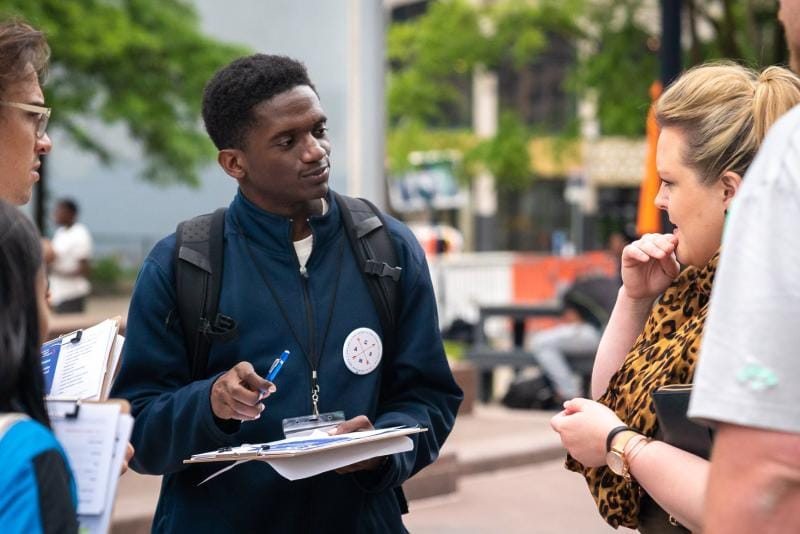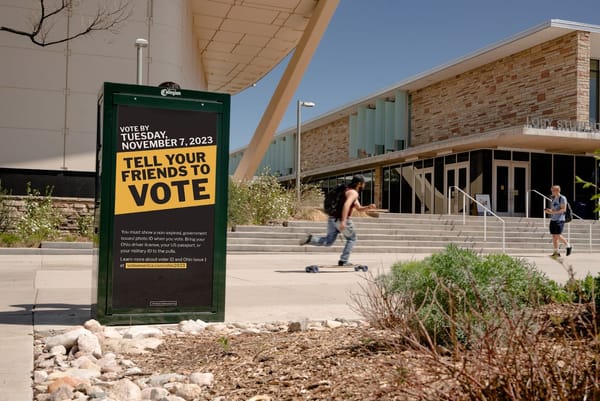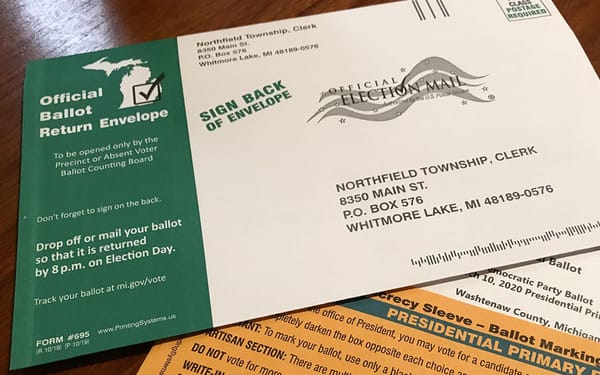Battleground state universities: an analysis of out-of-state student registration and voting

Prepared by Amelia Showalter, CEO of Pantheon Analytics. Research funded by Flytedesk. Reprinted with permission.
Flytedesk and Pantheon Analytics partnered to analyze voter registration and turnout data for a series of large universities in battleground states in 2022. While we looked at all students, we were particularly interested in out-of-state students at these universities. Turnout overall, and Democratic turnout in particular, were higher when out-of-state students registered on campus, rather than in their home state. This evidence suggests that both civic and progressive-leaning organizations should strongly consider on-campus registration drives targeting out-of-state students in 2024.
Overview
- The vast majority of the out-of-state students in our sample came from non-battleground states. Yet, only 8% chose to register in their campusʼs state in 2022, while 50% registered in their home state and 42% did not register anywhere.
- Among the out-of-state students who did choose to register in the battleground state where their university was located, turnout was quite high. Out-of-state students who registered in their campusʼs state turned out at a rate of 66%, versus only a 29% turnout rate for those who registered back home.
- Out-of-state Democrats who registered on campus turned out at a rate 14 points higher than out-of-state Republican students who registered on campus in the states where party registration was available.
- Taken together, these findings indicate that registration drives enticing out-of-state students to register on campus would be highly beneficial for both Democratic turnout and civic engagement overall
Voter File Match
Undergraduate student records from the following nine universities were shared with Flytedesk: Arizona State University, Augusta University, East Carolina University, Michigan State University, University of Nevada - Reno, University of North Carolina - Wilmington, University of Wisconsin - Eau Claire, University of Wisconsin - Madison, and University of Wisconsin - Whitewater. Although Flytedesk has access to records from more schools, these nine schools were chosen for this analysis due to their large populations, sizable proportions of out-of-state students, and locations in battleground states. Only undergraduates who had at least one full address listed in Flytedeskʼs records were considered eligible to be included in this analysis, and all eligible records were used.
In addition to the studentsʼ names, Flytedeskʼs student records contained three possible addresses for each student (home, campus, and mail address), and occasionally phone numbers or other information. The list was matched against a snapshot of TargetSmartʼs national voter file as it existed after Election Day 2022. Around 62% of records matched through one of three matching methods, each using a combination of name, address, and/or phone number to compare studentsʼ self-reported information to existing people on the national voter file.
The majority of matches (67%) were exact address matches. Other records were matched using name similarity and address proximity, and were given match confidence scores. These matches were only accepted if the confidence score was above 80%. Finally, we excluded any matches where the voter file record showed an age over 30, as these were more likely to be erroneous matches.
Registration Rates
We found an overall registration rate of 62% in the list – though, as weʼll discuss later, rates varied widely by campus. Out-of-state students (i.e. those listing at least one address in a state other than their universityʼs state) had a registration rate of 58%, slightly lower than that of in-state students who registered at a rate of 63%.
“Only 8% of out-of-state students chose to register in their campusʼs state, whereas 50% registered in their states of origin (the vast majority of which were not battlegrounds).”
Out-of-state students who did register overwhelmingly chose to do so in their home state, rather than the state where their campus was located. Only 8% of out-of-state students chose to register in their campusʼs state, whereas 50% of out-of-state
students registered to vote in their states of origin (the vast majority of which were not battlegrounds). Meanwhile, 42% of out-of-state students were not registered to vote anywhere in 2022.
At most of the schools in our sample, fewer than one in ten out-of-state students registered to vote in their campusʼs state. Two schools saw more substantial portions of their out-of-state students register in their campusʼs state: University of Wisconsin - Madison (24%) and Augusta University (18%). Still, even at these campuses, out-of-state students were still much more likely to have registered back home, even if the ratio was somewhat less skewed than average.
Turnout Rates for Out-Of-State Students
“Out-of-state students who chose to register in their universityʼs state increased their turnout by 37 points, relative to those who registered at home.”
Turnout in 2022 was remarkably higher among the out-of-state students who registered in their adopted state, rather than their home state. Those who registered in the state of their university turned out at a rate of 66%, versus a 29% turnout rate for those who chose to register in their home state. In other words, the out-of-state students who chose to register in their universityʼs state increased their turnout rate by 37 points, relative to those who registered at home.
When turnout rates were broken out by school, this trend generally held: students registered in the state of their university turned out at higher rates than those registered in their home states at eight out of nine schools, and the rates were roughly tied at the remaining one. Notably, turnout among out-of-state students at the University of Wisconsin - Madison and the University of Wisconsin - Eau Claire was incredibly high among those who chose to register in Wisconsin (89% and 80% turnout, respectively, versus only 24% and 36% turnout for the UW students registering back home). Wisconsinʼs status as a same-day registration state likely contributes to this high rate.
It is important to remember that self-selection may be a factor in these turnout differences between campus and home-state registrants. And as the varying campus results show, there may be campus- or state-specific factors that influence the degree to which students see turnout benefits from registering in their universityʼs state. Still, the trends are striking. It seems highly likely that getting more out-of-state students to register on campus would be a boon for civic participation overall.
Turnout and Partisanship for Out-Of-State Students
“Students who registered as Democrats in the state of their university turned out at a rate 14 points higher than those who registered in their universityʼs state as Republicans”
A party registration breakdown of out-of-state students reveals that students who registered as Democrats in the state of their university turned out at a rate 14 points higher than those who registered in their universityʼs state as Republicans and 15 points higher than those who were registered without a party affiliation. These Democratic students who registered in their universityʼs state were also more likely to vote than their fellow Democrats who registered in their home state (49% turnout versus 34% turnout). Of note, students at universities in Georgia and Wisconsin were excluded from this portion of the analysis since these states do not have party registration.
Conclusions and A Look Ahead
When students move to another state for college they face a choice of where to vote. Our research shows that out-of-state students who register in their schoolʼs state are much more likely to vote than students who register in their home state. Additionally, we know that 42% of out-of-state students and 38% of in-state students are not registered to vote anywhere.
These findings indicate that there is a large and electorally important target audience for campus registration drives in the battleground states of 2024. Students who are either registered in another state or who arenʼt registered to vote at all should be contacted by all groups who wish to increase civic participation among young people, and particularly by groups who support progressive candidates.



